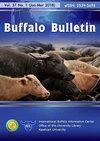水牛在越南农村不断变化的作用
IF 0.2
4区 农林科学
Q4 AGRICULTURE, DAIRY & ANIMAL SCIENCE
引用次数: 0
摘要
越南正在迅速实现工业化,周边许多以农业为基础的农村社区也不例外。例如,在河内周围地势较平坦的地区和首都以北一些省份人口较稠密的地区,汽油拖拉机正在取代水牛的劳动。此外,随着人们对肉类食品的需求增加,水牛现在通常是圈养起来供人食用,而不是用来提供农业耕作所需的动力。 事实上,就像杜延光省 Chiem Hoa 县的情况一样,曾经的犁头已经变成了可以销售的商品化肉类品牌。换句话说,水牛曾经是一种司空见惯的动物,每天都与人打交道,因其聪明而受人喜爱,因其顽固而遭人唾弃,被农村的许多人视为家庭中的另一个劳动成员,如今却显得有些异类,或者沦为另一种可消费蛋白质的来源。本章以水牛为中心,探讨了越南敦广省芹和县人民复杂的社会、文化、环境和经济历史,并由此推论出越南农村的历史。 尽管经济发展的论调在有关农村发展的学术文献中占据主导地位,但本研究的重点却是经济结构的变化。目前,越南的农业正在实现机械化和工业化,农村人口与他们最珍视的动物之间世代相传的共同历史正在被彻底改变。本文章由计算机程序翻译,如有差异,请以英文原文为准。
changing role of water buffalo in rural Vietnam
Vietnam is rapidly industrializing, and many of the rural agriculturally-based communities in the periphery are no exception. On the flatter lands around Hanoi and more heavily populated areas in some of the provinces to north of the capital for example, the gasoline powered tractor is replacing the labour of the water buffalo. Additionally, as the population demands more meat in its diet, water buffalo are now raised for human consumption, often in pens, rather than for power needed for agricultural cultivation. Indeed, as in the case of Chiem Hoa district in the Tuyen Quang province, what was once the plough has become a marketable and commodified brand of meat. Stated otherwise, an animal that was once common-place, interacted with daily, prized for its intelligence, decried for its stubbornness, and was considered by many across the countryside as another working member of the family, now seems somewhat exotic or has been reduced to simply another source of consumable protein. This chapter centres the water buffalo as a living framework to explore the complex social, cultural, environmental, and economic histories of the people of Chiem Hoa district in the Tuyen Quang province and by inference rural Vietnam. While the trope of economic progression dominates the academic literatures of rural development, this study focuses on structural changes in the economy notwithstanding. This present that agriculture in Vietnam is mechanizing and industrializing, and as it does generations of shared history between rural people and their most valued animal is being altered forever.
求助全文
通过发布文献求助,成功后即可免费获取论文全文。
去求助
来源期刊

Buffalo Bulletin
AGRICULTURE, DAIRY & ANIMAL SCIENCE-
CiteScore
0.50
自引率
0.00%
发文量
53
审稿时长
>12 weeks
期刊介绍:
Buffalo Bulletin is published quarterly in January-March, April-June, July-September and October-December. Contributions on any aspect of research or development, progress reports of projects and news on buffalo will be considered for publication in the bulletin.
 求助内容:
求助内容: 应助结果提醒方式:
应助结果提醒方式:


